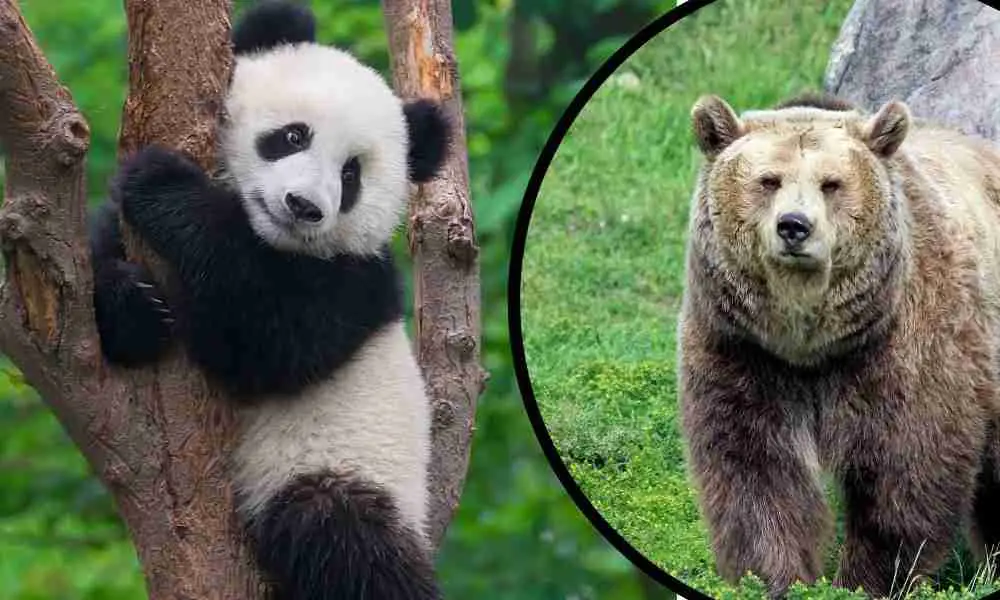The first impression of a giant panda might make you feel that it looks like a bear. Their huge size can make anyone get confused between the two. But why are giant pandas not bears?
Although giant pandas belong to the same Ursidae family as bears, they are not bears. This is because of the differences between giant pandas and bears.
For example, pandas are great climbers, whereas bears are not. Besides, they both have different eating habits.
Now that you know that giant pandas are not bears, you might be wondering how exactly giant pandas are different from bears.
Let’s find out!
How Giant Pandas Are Different From Bears?
You might be curious to know what makes a giant panda different from a bear.
Therefore, we have come up with a list of four major differences between the two.
Appearance

Although both giant pandas and bears are large mammals, they do differ in appearance.
Giant pandas can be recognized by their unique pattern of white and black furs. The color distribution around their bodies is similar to the distinct black teardrop-shaped marking around their eyes.
On the other hand, bears show a variety of body colors, including black, red, brown, and reddish-brown fur coats.
Pandas also have bigger heads than bears. But why so? Is it something related to their evolution? Let’s read further.
Evolution
Although they both belong to the same family in the animal kingdom called Ursidae (it is a family of mammals), they are different.
In the evolution timeline, the giant panda stepped on the ladder first. They came at least a hundred thousand years earlier than the bears.
Since they came one after another, how did they survive? Let us find out what kind of habitat they choose for themselves.
Natural Habitat

Giant pandas being native to Asia mostly prefers to stay in cold regions. They are mostly found in China’s cold regions like Sichuan, Gansu, and Shaanxi provinces.
Even among them, red pandas can also live in rainforests and survive through cold and a little hotter temperatures.
On the other hand, bears are known to be strong, wild, and adapting. They can be found in both extremely icy and warm regions.
Now the question comes: how do they stay? Do both Giant Pandas and Bears go into hibernation?
Let’s learn about this last distinct feature between them!
Hibernation
Giant Pandas do not hibernate. Because of their lazy temperament, giant pandas do not make efforts to find healthy food options.
They simply chew on bamboo for hours as it is the most readily available option.
Unfortunately, their favorite meal does not provide them with enough fat and nutrients to survive in winter without food.
On the other hand, bears do hibernate. Bears are very active in their daily lives.
They ensure to find healthy and nourishing food for themselves.
As a result, they have enough fat and energy storage to survive winter while remaining inactive.
READ OUR FULL ARTICLE: DO GIANT PANDAS MIGRATE?
Conclusion
In this article, we have learned four major differences between giant pandas and bears. They both differ in terms of their appearances, natural habitat, evolution, and hibernation patterns.
So, we can conclude that they might appear similar at first sight but are quite different from each other.
Finally, let us treat you to some fun facts about giant pandas!
- Baby pandas weigh around three to five ounces. They do not open their eyes until they get six or eight weeks older.
- Daxiongmao is a Chinese word that means giant bear-cat.
- China has reserved about four million acres of wildlife reserves to protect Panda’s habitat.
- They are also depicted on some Chinese coins.
- Kung Fu Panda became a record-breaker movie in both China and Korea and is celebrated today worldwide.
I hope you enjoyed reading the article and our additional treat of fun facts!
If you find this article interesting, do not forget to share it with your friends, colleagues, and anyone who likes to know about giant pandas.
To learn more about the differences and similarities between pandas and bears, read our full guide here!

